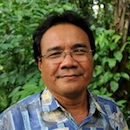BOGOR, Indonesia (8 October, 2012)_As negotiators prepare for the UN climate change conference (COP18) in Doha in December, protecting forests because of their critical role in mitigating climate change and in meeting sustainable development goals must remain a priority.
The internationally-backed climate mitigation scheme that pays developing countries to reduce emissions from deforestation and degradation, or REDD+, is moving forward — but slowly.
Finding funds to support such a scheme in the long term is proving to be a huge undertaking. While many options exist, investors seem unlikely to commit the cash needed until they see that REDD+ really works.
REDD+ is a performance-based mechanism and developing countries will receive financial support contingent on achieving emissions reductions.
Going forward, international donors will need to support forest-rich nations as they build their capacity to measure, report and verify (MRV) their carbon emissions reductions — vital to demonstrating impact.
Developed and developing countries must also take into account the carbon-rich ecosystems of mangroves and peatlands – a low hanging fruit, which until now, has been largely left out of the climate change debate.
Wetlands must not be forgotten in the climate change debate
While the amount of carbon stored and released from tropical forest is well documented, much less is known about the vital role that wetlands – peatlands and mangroves – play in contributing to and mitigating the effects of climate change.
Mangroves store up to five times more carbon than most tropical forests, protect coastal areas against storms and waves, regulate water quality, and provide emergency food to local communities in time of drought.
But about 20% of the worlds’ mangroves have been destroyed in the last 25 years — a much higher rate than many other ecosystems.
Peatlands cover just 3% of the Earth’s land area but store as much as one-third of global soil carbon. One tonne of crude palm oil produced on peatland generates up to 20 tonnes of carbon dioxide over 25 years as a result of forest conversion, peat decomposition and emission from fires associated with land clearance.
The international community has already taken a few steps to recognise wetland ecosystems as assets that help regulate climate change.
At the Ramsar Convention in Romania earlier this year, delegates agreed that wetlands should be included in REDD+ schemes. The UN Framework on Climate Change has also requested that the Intergovernmental Panel on Climate Change (IPCC) create wetlands guidelines specifically for greenhouse gas emission inventories.
However, world leaders attending COP18 in Doha need to do much more to ensure that wetlands are included in the REDD+ process.
A decision that specifically mentions the importance of mangroves and peatlands for carbon storage would send an important signal to the world. However, countries would still need the financial, political and technical support to ensure that sufficient mechanisms have been put in place to implement their protection.
The future of climate change financing
REDD+ is being touted as one of the best ways to protect forests and mitigate climate change, yet the long-term financing of this scheme remains uncertain.
At this year’s COP18, forest-rich countries will need a clearer signal from the international community that the $30 billion pledged for REDD+ activities between 2010 and 2012 and the $100 billion pledged annually by 2020 will actually be met.
So what are the options going forward?
In the future, most finance for climate change mitigation strategies will probably be mobilised by the public sector through development aid and other bilateral funds. Financing is therefore likely to be fragmented, and channelled through various agencies.
It is also likely to be tied to multiple objectives, in addition to the goal of climate change mitigation, including such issues as poverty alleviation and rural development.
Wealthier forest countries with stronger social and political institutions may opt to self-finance portions of national and international climate change mitigation strategies.
Some countries may choose to engage in performance-based agreements with donors and international agencies, such as Norway’s emissions reduction agreements with Indonesia.
While negotiators decide on a clear long-term strategy, the question over ‘who pays?’ for climate change solutions, here and now, will continue to cause controversy.
Should it be developing countries currently undergoing huge economic growth and industrial expansion, or developed countries that have been historically responsible for climate change?
Despite the bickering, the continued exploitation of resources is not an option for either party.
A transparent and accountable climate finance mechanism could help break this stalemate — the accurate measurement, reporting and verification (MRV) of emissions reductions would reassure REDD+ investors that payments were based on real emissions reduction impacts, while developing countries would gain financial or technical support for their emissions reduction activities. However, MRV is not without its challenges.
Counting carbon to guarantee REDD+ impact
One of the biggest technical challenges facing forested-nations making the leap into climate change mitigation strategies, such as REDD+, is how to accurately monitor deforestation, forest degradation and carbon stocks.
Central to the debate has been how to monitor carbon emissions and establish reference emissions levels (RELs); the reference point from which countries can measure their success in reducing carbon emissions.
However, to establish RELs, countries must have detailed information on the past, present and potential future state of their forests.
At the UNFCCC negotiations in Durban last December, it was agreed that the stepwise approach — developed by CIFOR and partners — would support countries that lacked detailed forest inventories to participate in REDD+ by allowing them to use simple monitoring, reporting and verification (MRV) methods to set their RELs, enabling them to develop more sophisticated and accurate measuring systems over time.
Building on this, negotiators at COP18 in Doha, will hopefully make some key decisions to provide financial and technical support to countries as they try to meet the MRV requirements. Final decisions on the structure of MRV systems will help the process move forward.
International negotiations on climate change are complex at the best of times, but we have learned since Copenhagen that the world is not likely to achieve a breakthrough in any one meeting. Progress will take time.
Accelerating the pace of REDD+ negotiations would be one way that the international community could signal that it is serious about addressing the challenges of climate change, and serious about protecting the world’s forest.
This article was first published by Responding to Climate Change as part of a week of forest stories. Follow the week’s reports on Twitter via #ForestWeek and leave your views on our Facebook page.
We want you to share Forests News content, which is licensed under Creative Commons Attribution-NonCommercial-ShareAlike 4.0 International (CC BY-NC-SA 4.0). This means you are free to redistribute our material for non-commercial purposes. All we ask is that you give Forests News appropriate credit and link to the original Forests News content, indicate if changes were made, and distribute your contributions under the same Creative Commons license. You must notify Forests News if you repost, reprint or reuse our materials by contacting forestsnews@cifor-icraf.org.

















